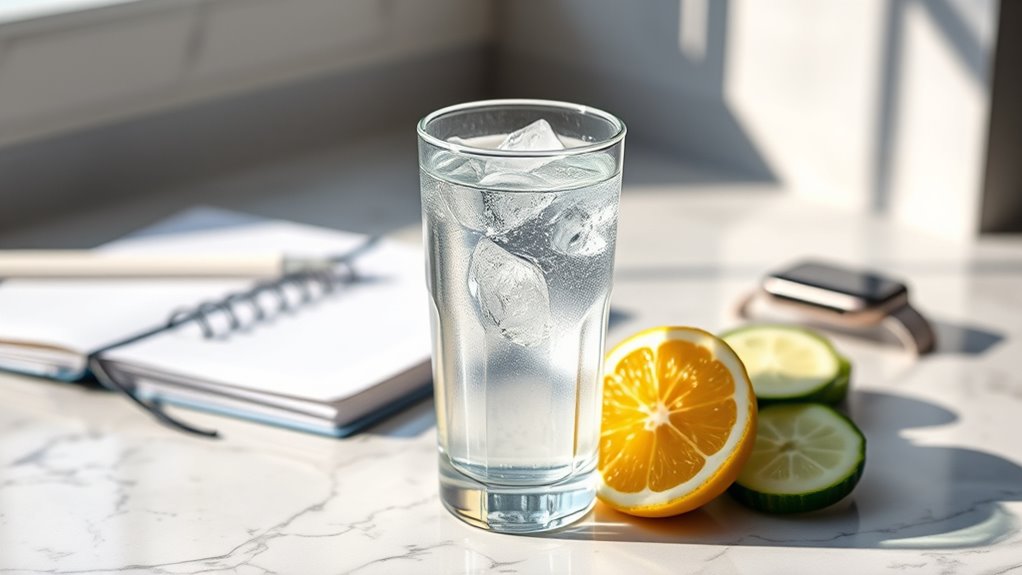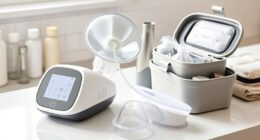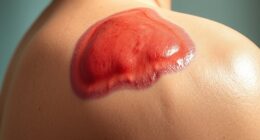Many believe you need eight glasses of water daily, but hydration needs vary based on activity, climate, age, and health. Thirst, urine color, and body signals are better guides than a set rule. Overhydration can cause serious issues like hyponatremia. Proper hydration is personalized, so paying attention to your body helps maintain balance. To learn how to fine-tune your fluid intake and avoid common misconceptions, keep exploring practical tips and insights.
Key Takeaways
- The “eight glasses” rule is a simplified guideline; individual hydration needs vary based on activity, climate, and health.
- Thirst and urine color are better indicators of hydration status than fixed water intake amounts.
- Drinking water constantly isn’t necessary; regular, moderate intake typically suffices for most people.
- Clear urine doesn’t always mean optimal hydration, and overhydration can lead to hyponatremia.
- Hydration strategies should be personalized, considering factors like activity level, environment, and body signals.
The Origin of the “Eight Glasses” Rule
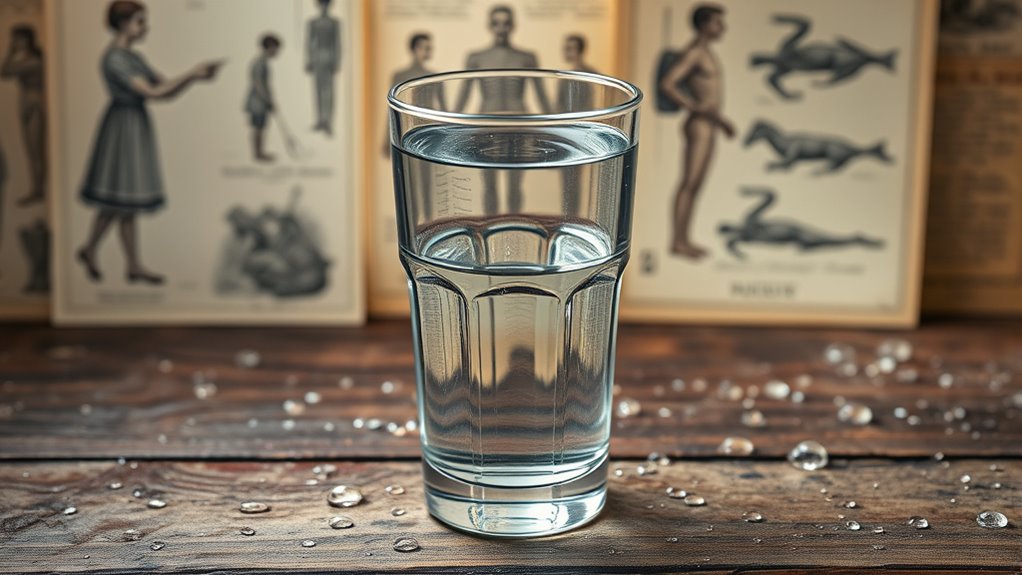
The “eight glasses” rule of hydration didn’t originate from scientific research but from a 1945 recommendation by the Food and Nutrition Board of the National Academy of Sciences. At that time, they suggested that adults need about 2.5 liters of water daily, mostly from food and beverages. The statement was later simplified to recommend eight glasses, or about two liters, making it easier for people to remember. However, the original report emphasized that much of this water intake comes from food, not just drinking water. Over time, the simple “eight glasses” mantra stuck, even though subsequent studies didn’t support a universal daily water requirement for everyone. So, while the rule is easy to recall, it’s not based on solid scientific evidence. Additionally, electric bikes demonstrate how technology can provide efficient energy solutions, similar to how understanding hydration needs can be more nuanced than simple rules suggest.
How Much Water Is Enough? Understanding Daily Needs
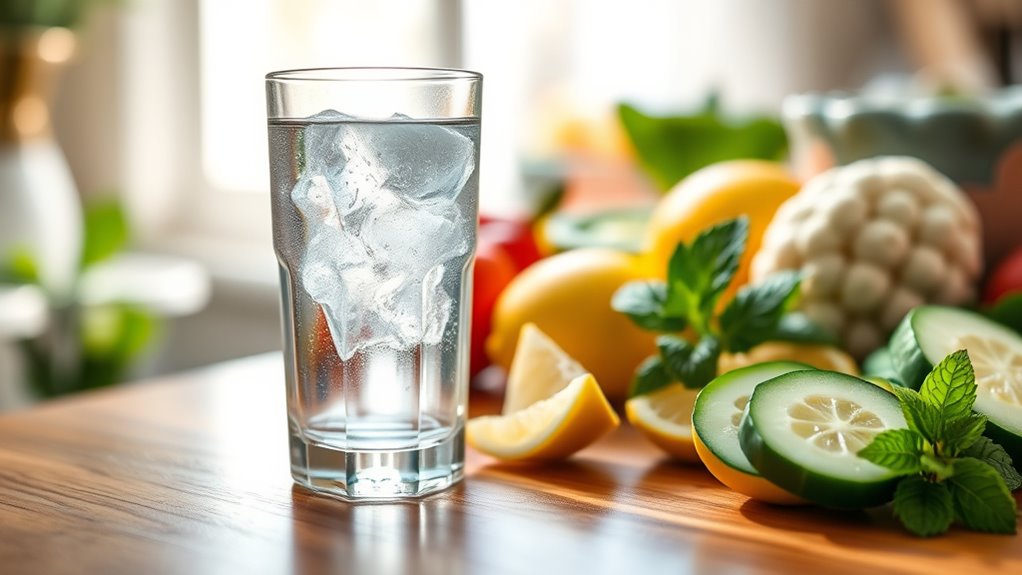
Determining how much water you need depends on factors like your activity level, climate, and health. The general recommendation is about 8 cups a day, but individual needs vary. Pay attention to signs of dehydration, such as dry mouth or fatigue, to guarantee you’re staying properly hydrated. Monitoring your daily water intake can help ensure you meet your body’s specific hydration needs.
Factors Influencing Intake
Understanding how much water you need each day depends on several key factors. First, your activity level plays a big role; the more you exercise, the more fluid you lose through sweat, requiring increased intake. Second, your environment matters—hot or humid conditions cause you to sweat more, boosting your water needs. Third, personal factors like age, health status, and pregnancy can change hydration requirements. For example:
- Increased activity levels demand more water.
- Hot climates elevate your hydration needs.
- Specific health conditions may alter your daily requirements.
- Monitoring body signals can help you assess your hydration status effectively.
Being aware of these factors helps you tailor your hydration to your lifestyle, ensuring you stay properly fueled without overdoing it. Recognizing what influences your intake empowers you to maintain ideal hydration for your individual needs.
Recommended Daily Amounts
Most people need about 8 cups (64 ounces) of water daily to stay properly hydrated, but individual needs can vary based on activity level, climate, and health. If you’re active, you’ll likely require more water to replace fluids lost through sweat. Hot or humid environments can increase your hydration needs, while cooler climates may reduce them. Certain health conditions, like illnesses or pregnancy, also influence how much water you should consume. It’s important to listen to your body’s signals and adjust your intake accordingly. While the “8×8” rule is a good general guideline, your ideal daily amount depends on your unique circumstances. Staying attuned to these factors helps ensure you meet your hydration needs without overdoing it. Understanding daily needs can help you tailor your water intake for optimal health.
Signs of Dehydration
Have you noticed feeling unusually tired, dizzy, or drymouth? These signs often point to dehydration. When your body lacks water, it struggles to function properly. Pay attention to these key indicators: signs of dehydration include dark urine, dry skin and lips, and muscle cramps. If you experience any of these, it’s time to hydrate more. Dehydration can affect your concentration, energy, and overall health. Recognizing these signs early helps prevent more serious issues. Keep in mind, everyone’s water needs are different, but staying alert to your body’s signals ensures you maintain proper hydration. Regularly checking these symptoms helps you stay in tune with your daily water requirements.
Factors That Influence Hydration Requirements

Several factors determine how much water your body needs each day, and these can vary widely from person to person. Your activity level plays a big role—if you exercise regularly or work in hot conditions, you’ll need more water to stay hydrated. Your age influences your needs as well; older adults may require less, but they’re also more prone to dehydration. Your health status matters too—illnesses like fever or infections increase your fluid requirements. Diet affects hydration, especially if you consume a lot of salty, spicy, or protein-rich foods. Environmental factors such as hot or humid weather cause you to sweat more, raising your hydration needs. Even your body size influences this; larger bodies generally require more water to stay balanced. Additionally, vehicle tuning can impact your hydration needs if it involves driving in extreme conditions that elevate physical stress.
Debunking Common Hydration Myths

Many common beliefs about hydration are actually myths that can mislead you into either under- or over-consuming water. For example, thinking you need eight glasses daily isn’t a one-size-fits-all rule. Here are some myths to watch out for:
- You must constantly sip water – Your body can maintain hydration through regular intake, so sipping all day isn’t necessary.
- Clear urine means perfect hydration – Urine color varies based on diet and medications; it’s not the sole indicator.
- Thirst is the best hydration sign – Sometimes your body’s signals lag, so don’t rely solely on thirst to gauge your hydration needs.
- Hydration can be measured solely by water intake – Using headphones and other devices, you can track hydration status more accurately through various indicators.
Understanding these myths helps you listen to your body more accurately while avoiding unnecessary water intake.
Recognizing Signs of Proper Hydration

Your body often signals proper hydration through thirst, so pay attention when you feel it. Check your urine color—pale and clear urine usually means you’re well-hydrated, while darker shades suggest you need more fluids. Recognizing these signs helps you stay on top of your hydration without relying on myths or assumptions. Additionally, staying informed about data privacy challenges can help you better understand how your health data is protected.
Thirst as a Signal
Thirst is often the body’s primary signal that you need to hydrate, serving as an immediate cue to replenish fluids. When you feel thirsty, it’s your body’s way of warning you that dehydration may be setting in. Recognizing this signal is vital for maintaining proper hydration. To better understand your body’s needs, consider these signs:
- You crave water or feel dry in your mouth.
- Your skin feels less elastic or slightly sticky.
- You experience a mild headache or fatigue.
- Monitoring hydration levels can help ensure you’re drinking enough water throughout the day.
These indicators show your body is signaling for fluids. Ignoring thirst can lead to dehydration, impacting your energy and overall health. Trusting and responding to your thirst cues helps you stay properly hydrated without overdoing it.
Urine Color Clues
Monitoring the color of your urine provides an easy way to assess your hydration status. Light, pale yellow urine usually indicates proper hydration, while darker shades suggest you need more fluids. If your urine is deep amber or brown, you’re likely dehydrated and should drink more water. Clear urine is also a sign of adequate hydration but can indicate overhydration if it persists. To help you interpret urine color quickly, here’s a simple guide:
| Urine Color | Hydration Level | Recommended Action |
|---|---|---|
| Pale yellow | Well-hydrated | Maintain current intake |
| Dark yellow | Slight dehydration | Drink more water |
| Amber or brown | Dehydrated | Increase fluid intake |
Proper hydration also involves understanding how optimal angles for pinball machines can influence performance, which is an interesting analogy for maintaining balance in your hydration habits.
The Role of Other Beverages and Foods in Hydration
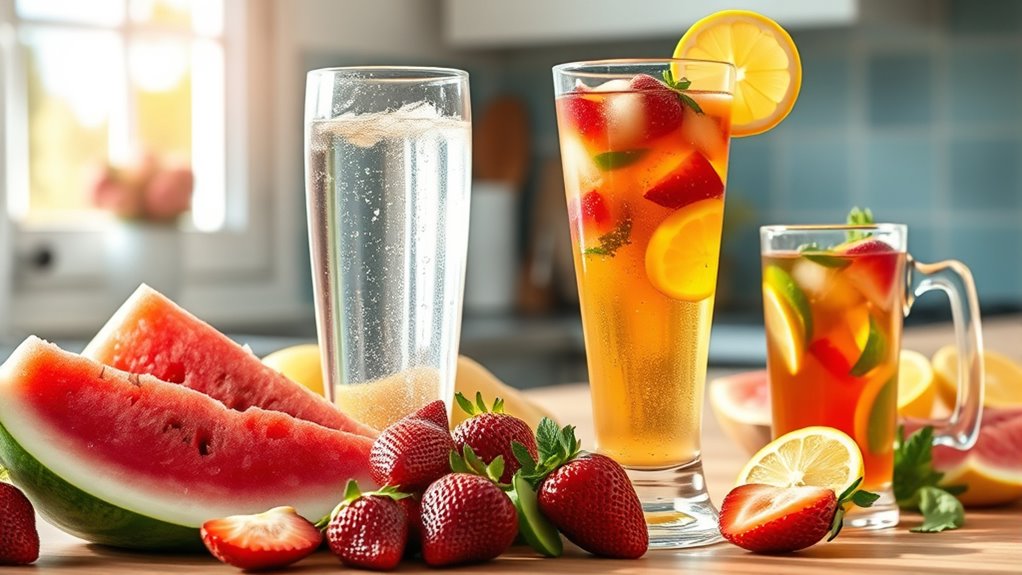
While water is the primary source of hydration, other beverages and foods also contribute considerably to your fluid intake. Drinks like milk, juice, and herbal teas provide hydration and nutrients. Foods such as fruits and vegetables, including watermelon, oranges, and cucumbers, contain high water content and support your hydration needs. To optimize hydration, consider these points:
- Incorporate hydrating foods daily to supplement fluid intake naturally.
- Choose beverages like herbal teas or diluted fruit juices to stay refreshed without excess sugar.
- Remember that many foods, especially produce, can provide more hydration than you might expect.
Balancing fluid sources guarantees you stay well-hydrated beyond just drinking water, making your overall intake more effective and enjoyable.
Hydration Tips for Different Lifestyles and Climates
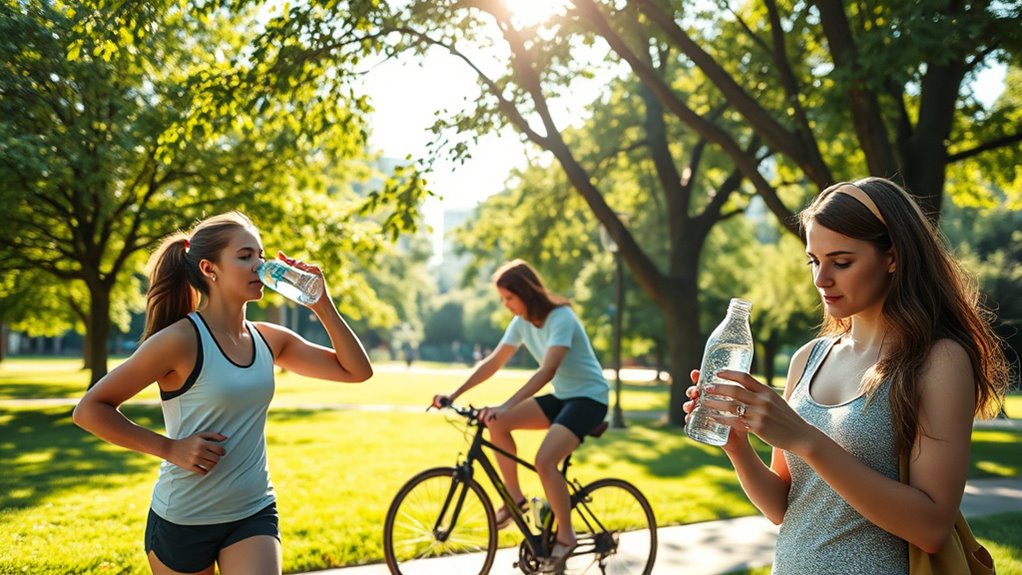
Adapting your hydration habits to suit your lifestyle and climate can make a significant difference in maintaining ideal fluid levels. If you’re active outdoors or live in a hot, humid area, you’ll need to drink more water throughout the day, especially during physical activity. Carry a reusable water bottle to stay consistent and avoid dehydration. In cooler climates, you might not feel as thirsty, but your body still loses moisture through respiration and skin. Adjust your intake accordingly, perhaps by including hydrating foods like fruits and soups. For sedentary lifestyles, spreading out your water consumption throughout the day helps prevent dehydration. No matter your environment, listening to your body’s signals and adjusting your fluid intake can help you stay properly hydrated.
Risks of Overhydration and Water Intoxication

Even when staying well-hydrated is important, overdoing it can pose serious health risks. Drinking excessive amounts of water can lead to water intoxication, also known as hyponatremia, which dilutes your blood’s sodium levels dangerously. This imbalance can cause symptoms like nausea, headaches, confusion, and in severe cases, seizures or coma. To avoid this, be mindful of:
- Quantity: Don’t force yourself to drink large amounts if you’re not thirsty.
- Pace: Spread out your water intake throughout the day.
- Signs: Watch for symptoms such as dizziness or swelling, which may indicate overhydration.
Understanding these risks helps you prevent dangerous health issues while maintaining proper hydration. Remember, balance is key to staying healthy.
Personalized Hydration Strategies

Your hydration needs vary based on how active you are, the climate you’re in, and your body type. Paying attention to these factors helps you drink the right amount without overdoing it. By customizing your strategy, you guarantee ideal hydration for your unique situation.
Tailoring Intake to Activity
Since hydration needs can vary widely depending on the type and intensity of activity, customizing your fluid intake is essential for ideal performance and safety. For moderate activities like walking or cycling, you might need less water—about 3-4 cups per hour. High-intensity or prolonged exercises, such as running or sports, demand more—up to 6-8 cups per hour. To tailor your hydration effectively:
- Monitor your thirst during activity to gauge your needs.
- Weigh yourself before and after to estimate fluid loss and adjust intake accordingly.
- Replace electrolytes during intense or long sessions to maintain balance and prevent cramps.
Considering Climate and Body Type
Climate and body type considerably influence your hydration needs, making personalized strategies essential. If you’re in a hot, humid environment, you’ll likely need more fluids than someone in a cooler climate. Similarly, your body size and composition affect how much water you require; larger or more muscular individuals often need higher intake. To illustrate, consider the following factors:
| Climate Type | Body Type | Hydration Adjustment |
|---|---|---|
| Hot & humid | Larger frame | Increase water intake |
| Cold & dry | Slim build | Moderate hydration |
| Moderate climate | Average build | Standard hydration |
| High altitude | Muscular | Boost fluids slightly |
| Humid & cold | Petite | Monitor hydration closely |
Personalized hydration plans consider these elements, ensuring you stay properly fueled no matter the environment.
Listening to Your Body: How to Know When You’re Hydrated
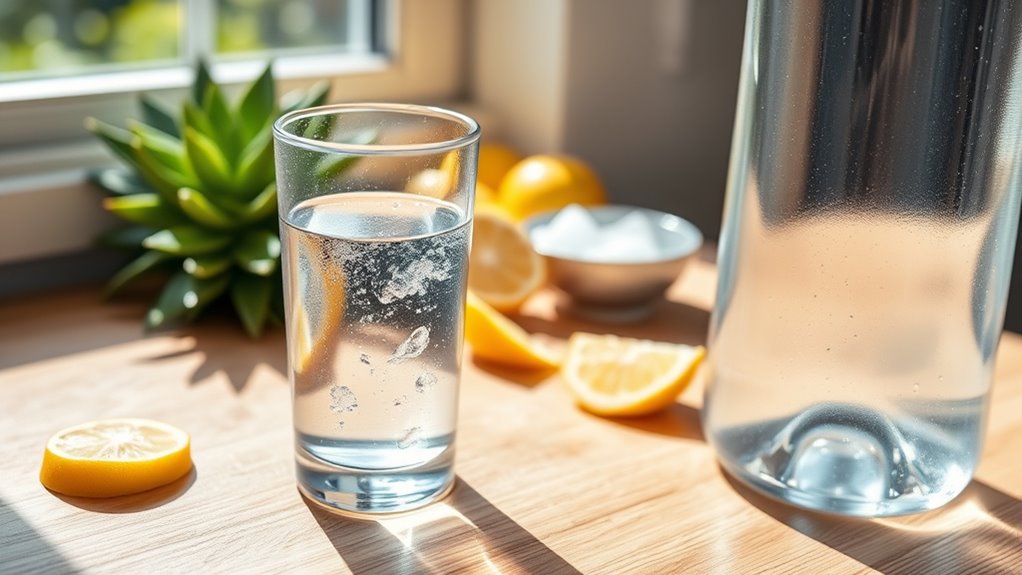
Listening to your body is one of the most reliable ways to gauge your hydration levels. Your body gives signals when you’re well-hydrated or need more water. Pay attention to these cues:
- Thirst: A clear sign you need to drink more—don’t ignore it.
- Urine Color: Light yellow indicates proper hydration; dark urine suggests you need more fluids.
- Skin and Mouth: Dryness or a sticky feeling signals dehydration.
Frequently Asked Questions
Can I Hydrate Effectively With Other Beverages Besides Water?
You can hydrate effectively with other beverages besides water, but it depends on what you choose. Drinks like herbal teas, milk, and diluted fruit juices can contribute to your hydration, but sugary sodas and caffeinated drinks may have diuretic effects that reduce hydration. Ultimately, prioritize water for ideal hydration, but including a variety of healthy beverages helps you stay well-hydrated and enjoy your fluids.
How Do Exercise and Activity Levels Alter My Hydration Needs?
When you exercise or stay active, your hydration needs increase because you lose more fluids through sweat. You should drink water before, during, and after activity to stay properly hydrated. The more intense or prolonged your workout, the more fluids you’ll need. Pay attention to your body’s signals, like thirst and the color of your urine, to guarantee you’re drinking enough to stay energized and healthy.
Are There Specific Hydration Guidelines for Children and the Elderly?
Think of your body as a delicate garden that needs just the right amount of water to flourish. Children and the elderly have unique watering needs—kids often require more for growth, while seniors may need less but more frequent hydration. Follow their cues, like thirst and urine color, and consult healthcare providers for tailored advice. Proper hydration keeps their bodies vibrant and resilient, like a well-tended bloom.
What Are the Long-Term Health Effects of Chronic Dehydration?
Chronic dehydration can lead to serious long-term health issues. You might experience kidney problems, urinary tract infections, and kidney stones. It can also cause fatigue, dizziness, and weaken your immune system. Over time, dehydration may contribute to chronic conditions like hypertension and cardiovascular disease. To protect your health, make sure you drink enough water daily and listen to your body’s signals for hydration needs.
How Do Medical Conditions Impact Individual Hydration Requirements?
Medical conditions can considerably change your hydration needs. If you have heart or kidney issues, your doctor might recommend drinking less or more water to prevent complications. Diabetes can cause dehydration, so you’ll need to monitor your intake carefully. Some illnesses increase fluid loss, requiring you to hydrate more. Always follow your healthcare provider’s advice, as your specific health circumstances determine how much water keeps you balanced and healthy.
Conclusion
Remember, hydration isn’t a one-size-fits-all. By understanding your body’s signals and considering your lifestyle, you can avoid the pitfalls of both dehydration and overhydration. Don’t fall for the myth that you need eight glasses no matter what—think of it as your personal quest, like Odysseus seeking true balance. Trust your instincts, stay flexible, and hydrate wisely. Your health journey is uniquely yours—so listen closely to what your body tells you.
